You’ve chosen your paint, you’re all set to go, and then you spot a label that says “natural paint” or “eco-friendly”. Suddenly, you are not only selecting a colour, but you are also wondering what is actually in the tin. Are natural paints really better than synthetic paints?
It can sound like yet another decision in a long string of things while renovating, but it’s worth knowing about, as many of us care about what goes into the air of our home. No, I am not going to get all technical up in here. Since we like to keep things real simple around here, let’s break down natural vs synthetic paint in general, to help you choose the best option for your space.
What Is Natural Paint?
Natural paint is exactly what it sounds like: paint fabricated from nature. Instead of the synthetic chemicals and petroleum derivatives that go into synthetic paint production, these paints contain only raw, renewable ingredients like plant oils, minerals, clay and natural resins. These are paints created with the planet and your health in mind.
Not only do they check the sustainability box, but they work well too. Pure natural paints might look or feel different to the manufactured, synthetic products we use today, but they do the same job, covering and protecting the surface, and adding colour. And, perhaps most importantly, they can do it without filling your home with noxious fumes or contributing to long-term pollution.
On the other hand, the difference with these natural paints is how they’re made and what happens to them once you’re done using them. Just for starters, the ingredients themselves are renewable, coming from resources like linseed oil, tree resins, beeswax, clay and natural pigments like ochre or umber. These are renewable resources, not the fossil fuels found in most of your typical paints.
Natural paint production is also kind to the environment. Fewer toxic chemicals are mixed into these, and, usually, the factories that manufacture them do so in a more eco-friendly way. And when you’re finished with natural paint, what you’ve kept around is not paint polluting your home air. Many of these paints are biodegradable, or compostable, meaning they’ll degrade in soil or water on their own. So, not only are you reducing the chemical load in your home, but you are also helping to cut down air and water pollution across the board.

What Is Natural Paint
Advantages of Using Natural Paint.
Changing to natural paint isn’t just an eco-conscious choice, although it is a huge motivator. It’s also about creating a healthier, more enjoyable home environment. Every time you might be painting a new bedroom, baby room, or at times an entire house, natural paint is so much better than it appears to be on the tin.
One of the first things people notice when they switch to natural paint is that the air quality is noticeably healthier. Conventional paints fume, and natural paints are low-VOC or no-VOC. No smell after the headache, no smell is left after the filament changeout. It’s a game changer for those of us with asthma, allergies or a sensitivity to chemicals and the safer choice even if you have kids or pets.
Another huge plus is how good for the environment natural paints are, in their production and degradation. These paints are simply created from renewable sources such as clay, chalk and plant oils, which are far less damaging to extract and process than synthetic chemicals. Any paint that remains and isn’t used or has gone bad after painting is much less harmful to the planet, since many natural formulas are biodegradable or compostable. So, no, you are not just painting your walls, you are shrinking your footprint.
Natural paints are also going to give your walls a little extra visual zing. They’re also often a bit softer and less shiny, softly reflecting light and with the feel of being lived in. Because they are using real mineral pigments, the colours can feel even more earthy and grounded, and not flat and fake. The slightly mottled or textured look some natural paints provide is cherished by many. It just adds a twinkle of character and depth that you can sometimes miss with synthetics.
And although they may be costlier with the possibility of needing an extra coat or two for covering a surface, natural paints can often make a little go a long way, in transforming a space into somewhere calm, safe and wholly personal. They sound like a good match if you’re not worried just about how your home appears, but also about how it feels to live in, daily. In short, using natural paint is not just about colour; it is about health, sustainability, and designing a better space – and not just inside it either. Click here to view common natural paint brands.
Now What About the Limitations of Natural Paint.
While natural paints may be more ecological than synthetic ones, they still have their drawbacks. You need to know what these limitations are, so that you can work out where and when they make the most sense.
The biggest drawback with natural paint is its durability. Some can be pretty substantial, such as lime- or clay-based ones, but generally they don’t hold up as well as those manufactured from materials. For example, if you have a busy kitchen or a damp bathroom (where surfaces are regularly being wiped down), you’re safer using synthetic paints. Natural paint will probably be more prone to marks and may wear quickly or require recoating in such areas.
Ease of application is another restriction. Natural paints are frequently quite different from artificial ones, taking longer to dry and sometimes needing several coats for a uniform colour scheme. There’s special preparation work beforehand too: increasing the number of pairing times in order not only means harder labour but also may increase your risk of cracking open fingers. Some also have a thicker or more textured consistency, which can be somewhat difficult to handle if you are used to regular wall paint. In some cases, particularly with limewash or clay paint, it may be a feature of the product that the final coat looks slightly irregular or “patchy,” a style that not everyone appreciates.
Availability and cost are further stumbling blocks. Natural paints are not necessarily available at your local hardware store, which means the likes of mail-order suppliers or retailers in specialist shops may have to substitute for them. And because they are made from superior materials in smaller quantities, they tend to cost more than ordinary paints. If your renovation budget is tight or you need to do a large-scale painting job, then this natural paint may not be your best choice.
Now let’s see what actually goes into a tin of natural paint and why these ingredients matter.
- Binders are what make paint adhere to surfaces and stay there. Plant oils like linseed, soya, or sunflower oils lay the base instead of plastic polymers in natural paints. These are biodegradable and derived from sustainable sources.
- The paint gets its colour from pigments. In natural paints, that means minerals or plants. Burnt sienna and ochre are typical earth tones, but there are also softer blues, greens and greys all made without synthetic dyes from many natural brands.
- Fillers add body and texture. Examples of natural options would be clay, chalk and limestone. These materials assist the paint to apply smoothly and coat surfaces without requiring synthetic additives.
- Solvents get the paint to flow out and dry the way it should. In most man-made paints, the solvents will be derived from the petroleum industry. But by natural paints, they might mean water or mild solvents such as citrus oil or pine terpenes (far less harsh, and far better for both the planet and your lungs).
It’s especially ideal for bedrooms, living rooms, nurseries, and home offices, really anywhere that would benefit from fresh, clean air and a tranquil, toxin-free ambience. It’s also a good choice for older properties or listed buildings, where more breathable materials like limewash may be more suitable to the original construction.
In terms of which homes or businesses would be best served by natural paint, it would be especially beneficial to those looking to make their indoor living spaces healthier environments, such as homes with young children, allergy sufferers or individuals with a sensitivity to chemicals. It is also a top pick for homeowners who are environmentally conscious and want to minimise their footprint without sacrificing beauty. Designers and architects focused on sustainable or low-impact builds often gravitate to natural paints for the same reasons they’re hunting for materials that meet green building standards and reflect healthy living objectives.
So while natural paints will not be the right choice for every room or every price point, they are indeed a smart, thoughtful choice for the right project. If you’re a fan of clean air, kind ingredients and a more earthy look, they’re worth a look.
What Is Synthetic Paint?
Synthetic paint is the paint that is formulated using chemicals rather than natural materials. Synthetic Paints are specialised paints that, even though they are being perfected with advances in polymer chemistry and factory precision, are tailored to unique needs. Traditional paints are created using elements naturally found in the environment (i.e. linseed, earth minerals, plant growth/fruit and plant dyes), whereas a synthetic paint is created within a laboratory with the combination/ingredients that include synthetic resin, pigments and additives.
Two examples of synthetic paints are alkyd (oil-based) and acrylic (latex and water-based). Both are best suited for different applications. Acrylics are for interior dry walls, while alkyds are recommended for wood and metal. Alkyds also offer greater strength compared to other paints, which further supports engineered synthetic paints. Explore more polymer resin coating types. Synthetic paints offer a heightened level of consistency, durability, and flexibility while also providing a wide range of applications, including the painting of vehicles, coating industrial machines, or home interior touch-ups.
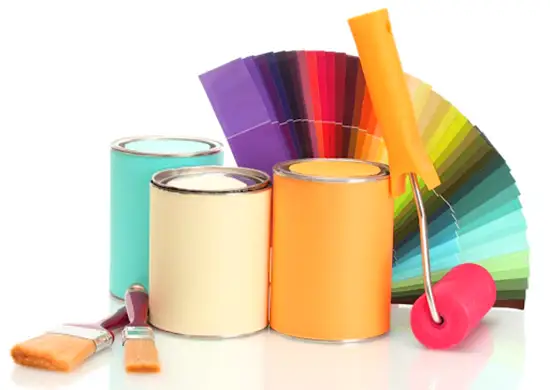
Mixing paint yourself – synthetic paint
The core components of synthetic paint include:
- Synthetic Resins (Binders): The film-forming materials that ensure the paint stays together and sticks to the surface. Typical examples include synthetic resins of acrylic type, alkyd type, and polyurethane type. They influence the paint’s lustre (such as gloss or matte) and its ability to stand up to the weather, chemicals, and wear and tear.
- Pigments: Artificial dyes add colour and opacity. Although other pigments might still come from natural sources, synthetic versions offer a wider variety of colours and also tend to be more resistant to light and environmental stresses.
- Solvents: These control the viscosity of the paint for easier application. In oil-based synthetic paints, mineral spirits or other petroleum-derived solvents are used. Water serves as the solvent in many water-based (latex or acrylic) synthetic paints.
- Additives: A large number of additives are incorporated to provide properties such as drying-time, fungi-resistance, UV safety, flow and levelling. These have been optimised to enhance performance under a wide variety of conditions.
Synthetic paint is professionally produced using chemical engineering that meets industrial demands, but with exacting consistency in quality and performance. Everything from the raw materials to the finished product on the shelf, each step is built for efficiency, precision, and longevity. It starts in industrial-scale, climate-controlled mixing plants, where synthetic resins, solvents, and performance-enhancing additives are added to industrial vats. That pre-mixing process makes sure that all of the liquid parts are mixed really well to create a base that will evenly carry pigments and binders.
The next step is pigment dispersion, which is a critical step in which synthetic pigments are ground down finely and added to the mix. To reduce the size of pigment particles and disperse them uniformly through the mixture, high-speed dispersers or bead mills are used. It helps to give the paint a uniform colour, opacity, and coverage when applied.
The resulting blend is milled and adjusted to get the desired fineness for the pigment. It shapes the paint texture and uniformity in this stage, meaning that the particle size is reduced and any lumps or places of irregularity are removed. The texture of the paint on a surface directly affects the finished effect of the paint, how shiny it is and how smooth it feels. Just in case, the paint would then go through quality control tests. Laboratory technicians test for important properties like colour accuracy, viscosity, drying time, adhesion strength and environmental resistance. Any differences from the required specifications directly result in formulation modifications before being approved.
At last, once the paint has passed all quality checks, it is filtered and then packaged. This is poured into sealed vessels, from small cans used by homes to big drums for factories, ready to be sent out to a retailer or to an end user. Each batch is traceable, ensuring that every can of synthetic paint not only meets but often exceeds industry standards for performance, reliability, and safety.
Scope of Applications of Synthetic Paint.
Synthetic paint is a much-needed product that has found its application in various industries thanks to its strong, durable and versatile properties, as it can easily be modified to suit specific conditions. Its designed formula lets it suit the purposes of both household adornment as well as heavy-duty industrial defence.
Architectural and Interior Use
Both commercial and residential buildings often use synthetic paints. Particularly, due to their fast drying, low cracking and bright colour fastness, acrylic and latex-based selections are most common for walls, ceilings and trim work. Being low odour and easy to clean makes them very useful in indoor applications as well.
Automotive Industry
Synthetic paints are integral to the automotive world, which includes polymeric system-based paints, particularly polyurethane and acrylic-based paints for vehicle body painting. In addition to giving a car a shiny, good-looking coat, topcoats and ceramic coatings also protect against UV rays, corrosion, chemicals, and scratches, helping vehicles withstand the elements and look as good as new.
Synthetic paints are used for different metal structures, machinery, pipelines, and other equipment. Alkyd, Enamel coatings and epoxy-based formulations are known for their durability and resistance to abrasion, moisture, chemicals, and high temperatures. Such coatings are vital within the oil and fuel, manufacturing, and marine sectors.
Furniture and Wood Finishing
Synthetic enamels and varnishes are commonly used to coat wooden furniture, doors, and cabinetry. These paints enhance the appearance of wood while also protecting it from moisture, termites, and everyday wear.
Art and Decorative Applications
Graphic artists and designers might use synthetic paints like acrylic. They dry quickly, have high pigmentation, and adhere to virtually any surface (canvas, wood, plastic, or metal), making them perfect for fine art and decorative crafts.
Road and Infrastructure Markings
Durable Synthetic bituminous or cementitious paints are used in road markings, road signage, parking lots, and airport runways. These paints are made to be highly reflective, able to withstand all weather conditions, heavy traffic and exposure to the elements.
The high versatility, performance, and innumerable advantages of synthetic paint have made it a popular option in numerous industries. From shielding a bridge, to interior house paint, to final finishing a car, synthetic paint is designed and made to endure and to serve. Click here to view common synthetic paint brands.
Typical Paint Types of Natural Paint.
The raw materials in natural paints are mainly unrefined, taken straight from nature! And, unlike man-made paint, they don’t use petrochemicals or heavy metals, making them a more eco-friendly and healthier choice. Here are some of the most common types:
These paints use water as the primary solvent and often include natural binders like casein (a milk protein), lime, or clay. They are breathable, low in odour, and non-toxic, making them ideal for interior walls, especially in homes sensitive to chemicals or allergens. Some popular varieties include clay paint and lime wash.

Brand Example: Earthborn Claypaint
A popular choice for eco-conscious homeowners, Earthborn’s Claypaint is crafted from natural clay and minerals and has a soft matt finish that helps to regulate humidity. Unlike synthetic paints, it’s VOC-free and comes in calm, nature-inspired tones ideal for a serene, allergen-free living space.
Plant-Based Paints.
Plant oils and resins form the backbone of these paints. Linseed oil (from flax seeds), tung oil, and other plant-derived oils are used as binders, while natural pigments (like ochres and iron oxides) provide colour. These paint types are available in a rich, warm finish and are ideal for woodwork, furniture and cabinets.
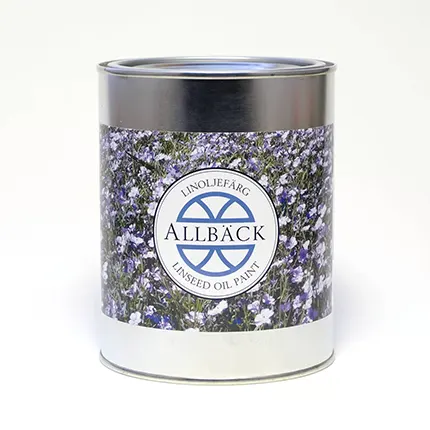
Brand Example: Allback Linseed Oil Paint
An all-time Swedish classic, Allback’s paint is made with raw linseed oil and pine resin according to very old recipes. It goes deep into wood pores for maximum protection and has a rich, warm, hand-rubbed colour. It develops a natural patina with age, so it’s a favourite choice for anything with a vintage look, doors, windows, or furniture.
Shellac-Based Varnishes.
Shellac is a natural resin produced by the lac bug and harvested from tree bark. It is dissolved in alcohol to make a fast-drying, glossy varnish that is applied as a finish in woodworking. Shellac-based products are great for colouring and sealing your project without toxic fumes.Cannot be shipped to Canada, Alaska, Hawaii, or Puerto Rico.
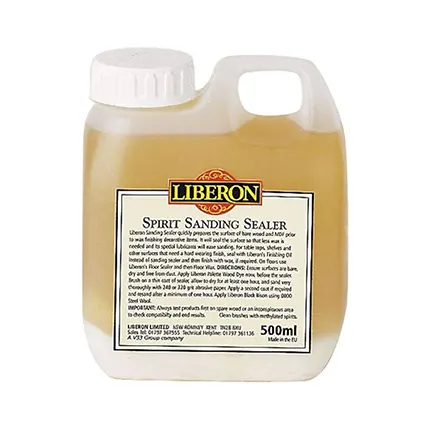
Brand Example: Liberon Shellac Sanding Sealer
A go-to for woodworkers and restorers, Liberon’s shellac creates a smooth, hard-wearing base for varnishes or wax. Unlike synthetic sealers, it’s non-toxic and enhances the wood’s natural grain, making it ideal for antique furniture and musical instruments.
Clay Paint.
Clay paint is an old form of natural paint that utilises natural clay as its base and comes in a variety of earth tones from the pigments that are either natural or have been added, and are available in a few variations, such as natural starch and casein as natural binding agents. It is known as chalk paint due to its velvety, smooth texture. The matte chalk finish is perfect for interior walls. The paint made with clay is not harmful at all; it is environmentally friendly, and it regulates humidity, absorbing and releasing its moisture. The warm, understated tones of its natural minerals help them bring beauty and character to even the most demanding environments. Although not as durable as synthetic paints, clay paints are simple to use, to repair, and a healthy alternative for those looking for environmentally friendly decoration in the home.
What Types of Synthetic Paints Are There?
There are many types of synthetic paints, and each is designed to work in a specific manner and to work under varying conditions. Whether it is the walls in our homes or the machinery used in industry, the variety of synthetic paints available is based on the material surface and whether it will be exposed to weather or chemicals, along with the finishes to be achieved. Here are the main types:
Amongst the best known are solvent-based synthetic paints called oil-based paints. These utilise a chemical solvent, such as mineral spirits, as the liquid vehicle. Solvent-Based Paint Known for high-gloss, premium and superior quality adhesion, solvent-based paint is often used on wood and metal surfaces. For exterior and high-traffic applications, a durable paint is required. They create a durable, high-gloss film that’s highly resistant to wear and tear. However, because they are stinky and full of VOCs, you will have to make sure that they are well ventilated and set up to dry, often overnight.
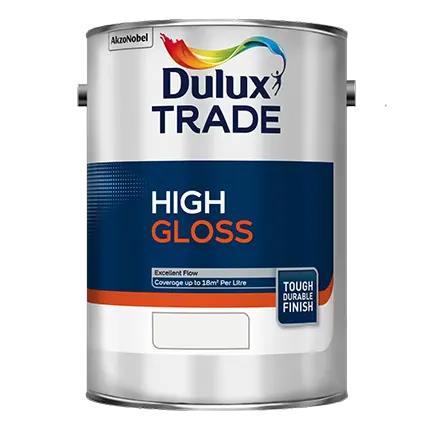
Brand Example: Dulux Trade High Gloss
An excellent high opacity finish for doors, trim and other interior surfaces. Ideal high opacity finish for new wood and metalwork. Remove as much product as possible from the application equipment before cleaning. It’s more powerful than water-based options, but it necessitates a well-vented space because of strong fumes.
Water-Based Paints.
In contrast, water-based synthetic paints, commonly called acrylic or latex paints, have gained popularity for being more user and eco-friendly. They are water-based paints as the main solvent, and tend to dry quicker, have less odour and clear up more easily. The acrylic resins used in the paints offer the best performance in terms of flexibility, hide and sun damage resistance. And the same resins paint manufacturers use in leading products create dependable stability.

Brand Example: Sherwin-Williams Duration Home
Rated one of the best exterior paints, Duration exterior is available in 60 colours, which are excellent for indoor applications and resistant to buckling, cracking, mildew and UV damage. A self-priming formula that delivers fewer coats on big projects.
High-Solids Paints
The most advanced is high-solids paint, a thicker, less solvent-dense paint with an even higher pigment loading. These paints provide excellent coverage and shows resistance with fewer coats and are especially effective in industrial and marine environments where endurance and corrosion resistance are key. Their low VOCs have also made them a popular choice in environmentally restricted applications.
Brand Example: AkzoNobel International
Applied to vessels, bridges and plants, AkzoNobel’s high-solids paint offers hard protection against corrosion, without the high levels of volatile organic compounds (VOCs) required to comply with stringent environmental standards.
Epoxy Paints
Epoxy paints are a two-part system, consisting of an epoxy resin and a hardener. They form an exceptionally tough, chemical-resistant surface when combined. Epoxy formulations are based on cementitious coatings like those used on the floors where waterproofing is required.
Brand Example: Jotun Jotamastic 87
A heavy-duty epoxy for steel and concrete in harsh environments (think oil rigs or chemical plants). It cures into a near-indestructible shield against rust and acids.
Polyurethane Paints
Polyurethane paints are known for their extraordinary gloss, long-lasting abrasion resistance and durable UV protection for surfaces that are exposed to strong environmental conditions. They are popular in automotive finishes, for aircraft, and are great for outdoors.
Brand Example: Sherwin-Williams Polane
Aircraft and machinery coatings rely on Polane for its abrasion resistance and lasting colour, even under constant sun and wear.
While “enamel” refers to a type of finish rather than a specific formulation, synthetic enamel paints typically use alkyd or acrylic bases. They dry to a hard, glossy surface and are ideal for high-traffic or high-moisture areas like kitchens, bathrooms, and machinery.
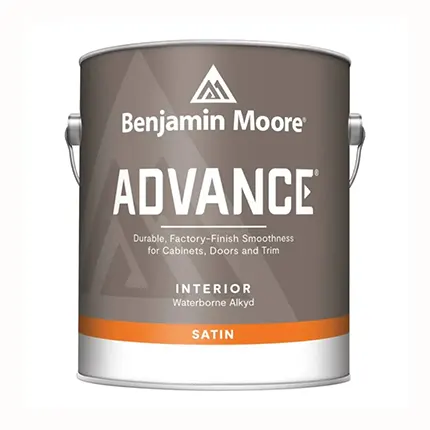
Brand Example: Benjamin Moore Advance
A waterborne alkyd hybrid, Advance levels out smoothly like oil-based enamel but cleans up with water. Perfect for cabinets and trim that need a pro finish without the fumes.
Each of these man-made paint varieties is designed for a particular application, and can be tailored according to gloss level, texture, drying speed, chemical resistance, or even Physical safety. This versatility is one of the reasons that synthetic paints have established a dominant position in both consumer and industrial markets.
Natural Paint vs Synthetic Paint.
Choosing the wrong paint is disastrous, but many homeowners do not realise this until it is too late. Failing to distinguish between natural and synthetic options leaves your family at risk of harsh chemicals that stay for weeks, cause allergies, or trigger respiratory illnesses. Cheap paints tend to crack, peel or fade earlier than their life span, which will make you redo the complete work a lot earlier than intended. It’s the overall economics: far too many standard paints spew off volatile organic compounds (VOCs), which contaminate the internal atmosphere and damage the outside setting. Final results can even suffer, too from uneven coverage and dull finishes, to colours that change over time.
Last summer, my friend Sarah learnt the hard way when it comes to paint choices. She bought some of the cheapest synthetic paint available and was looking forward to redecorating her nursery before the baby was born. As a result, three days after the house was painted, the room smelled of chemical fumes. She got high blood pressure; her husband started having migraines, and they had to delay months to move the crib. The paint also peeled around the windows within months, even after the ventilation provided by airing. She called me in tears, her lovely nursery was destroyed just because she was simply not aware of the real differences between paint types when she picked up paint for her nursery.
That is why it is so important to choose the right coating for our interior painting. Choose the best option for health, longevity for your home. For more convenience here, we break down the differences between paints and will prevent you from making mistakes.
| Aspect | Natural Paint | Synthetic Paint |
|---|---|---|
| Composition | Made from natural ingredients such as plant oils, clay, lime, casein, and minerals | Made from chemically engineered substances like acrylics, alkyds, epoxy, and solvents |
| Durability | Generally less durable, especially in high-moisture or high-traffic areas | Highly durable, resistant to wear, chemicals, and weather |
| Drying Speed | Slower drying time; it varies based on ingredients like oil or lime | Fast drying, especially water-based variants like acrylics |
| Finish Quality | Offers a more matte, rustic, or natural look; limited sheen options | Wide variety of finishes: matte, satin, gloss, with smooth, consistent texture |
| Cost | Typically more expensive due to natural sourcing and artisanal production | Generally, more affordable and mass-produced |
| Environmental Impact | Low; biodegradable, non-toxic, low or no VOCs | Can have high VOC levels (especially solvent-based); newer formulas are improving |
| Lifespan | Shorter lifespan; may require more frequent touch-ups or reapplication | Long-lasting, often years of performance with minimal maintenance |
As someone who has spent years helping homeowners rethink what goes on their walls, I can tell you this: the paint you choose doesn’t just coat your home, it fills your air, touches your skin, and stays with you for years. The truth is, synthetic paints may give you durability and bright finishes, but they often come with invisible costs: indoor air pollution, lingering VOCs, and ecological harm. Meanwhile, natural paints made from clay, plant oils, and minerals don’t just look beautiful, they breathe with your home. They’re safer for kids, better for allergies, and gentler on the planet.
Sure, a natural paint might be more costly or require an additional coat, but it comes with invaluable benefits such as a healthier living environment and peace of mind. Before choosing the easy option, consider what kind of space you truly want to create. Don’t just use your walls to reflect light; let them reflect your values, too. And if you need help identifying a suitable brand or type, feel free to leave a comment or contact us, and we will help you find a solution. A better home begins with smarter decisions.
FAQs
Are natural paints suitable for exterior use?
Natural paints can be used outdoors, but their performance varies. Lime wash and clay paints allow walls to breathe, which helps prevent moisture buildup. However, they may require more frequent reapplication than synthetic paints, especially in harsh weather conditions. For best results, ensure proper surface preparation and consider applying a protective topcoat if needed.
Is natural paint better for health than synthetic paint?
Natural paints are generally safer for indoor air quality because they contain fewer or no volatile organic compounds (VOCs). This makes them a good choice for people with chemical sensitivities, allergies, or for use in children’s rooms. Synthetic paints, especially oil-based ones, can release stronger fumes and higher levels of VOCs, so proper ventilation is important when using them.
Can I use synthetic paint over natural paint?
Applying synthetic paint over natural paint is possible but requires careful preparation. Water-based synthetic paints (like acrylics) usually adhere better to natural paints if the surface is clean and primed. Oil-based synthetic paints may not bond as well and could trap moisture, leading to peeling. Always test a small area first and ensure the surface is properly prepared before full application.
How long does natural paint take to dry compared to synthetic paint?
Natural paints, such as clay or lime-based varieties, typically dry more slowly than synthetic paints, often taking 24–48 hours to fully cure. Synthetic acrylic paints may dry to the touch in just a few hours. Factors like humidity, temperature, and ventilation can affect drying times, so follow the manufacturer’s recommendations for best results.
Do natural paints offer the same colour variety as synthetic paints?
While natural paints traditionally had limited colour palettes (earthy tones like whites, ochres, and muted hues), modern advancements now offer a wider range of pigments. However, synthetic paints still provide more vibrant and diverse colour options. For custom shades, some natural paint brands allow tinting with mineral-based pigments.

